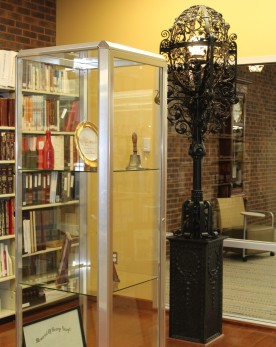By Jared Olar
Library assistant
Last month, in an exploration of some of the lost place names and forgotten settlements of Tazewell County’s, we reviewed a bit of the history of the proposed town of Cincinnati, which never was a separate town but instead became Pekin’s Cincinnati Addition.
This week, we’ll conveniently compile the references to the “aborted” town of Cincinnati from the standard publications on Pekin’s history.
Let’s start with “Pekin: A Pictorial History,” which was published by Herget Bank in 1998 and updated in 2003. On page 10, we find two brief mentions of Cincinnati. First is the caption to the photo of Jacob Tharp, father of Pekin’s founding settler Jonathan Tharp. The caption says:
“Jacob and a brother erected a permanent dwelling next to Jonathan and his family in 1825 and, being from Ohio, laid out a town they called ‘Cincinnati.’”
Just below that caption, we find the following text in a grey box:
“It seems appropriate to attempt an explanation of the unusual mixture of triangular intersections, jogs, and other odd features of the layout of [Pekin] city streets. In 1831, two rival land-owning groups plotted their ground next to each other, using different layouts. One plotted the town of ‘Cincinnati,’ using a strict north/south grid; the second group plotted the town of ‘Pekin,’ following the line of the Illinois River bank, which resulted in a northeast/southwest grid.”
Though there is no indication that the grey box text is a quote, in fact it comes directly from the 1974 Pekin Sesquicentennial, which has the following account on page 23:
“. . . but first it seems appropriate to attempt an explanation – especially for newcomers — of the unusual mixture of triangular intersection, jogs, and other odd features of the layout of city streets.
“In 1831 (after the land auction in Springfield discussed in the Overview) two rival land-owning groups plotted their ground next to each other, using different layouts. One plotted the town of ‘Cincinnati,’ using a strict north/south grid; the second group plotted the town of ‘Pekin,’ following the line of the Illinois River bank, which resulted in a northeast/southwest grid.
“Other land owners who acquired their property after the 1829 land auction did not develop their holdings into lots immediately. When they did (during the mid-1830’s), they followed the north/south grid established by ‘Cincinnati.’ Broadway, which followed the grid system of Cincinnati, separated the two original street systems. Court Street was the only thoroughfare extending out of ‘Pekin’ into ‘Cincinnati’; the intersection of this northwest/southeast street with ‘Cincinnati’s’ north/south ones accounts for many of the confusing intersections west of Eighth Street.
“When the County Seat was moved to Pekin from Mackinaw, the town ‘Cincinnati’ was made an addition to the town of Pekin by an Act of the State Legislature – hence, our present system of unusual street layouts in the older part of Pekin. (A re-reading of this section with a city map in hand would prove beneficial if you are still confused.)”
Given that we know the plats of Pekin and Cincinnati were both completed and filed in 1830, it appears the Sesquicentennial is off a year in its date of when the “two rival land-owning groups plotted their ground next to each other.”
The aborted plans for the town of Cincinnati are not discussed in the 1949 Pekin Centenary, nor in William H. Bates’ account of Pekin history which he included in the 1870-71 Pekin City Directory. However, Ben C. Allensworth’s 1905 “History of Tazewell County,” page 899, notes as follows:
“The original Town of Pekin was enlarged in 1830 by the addition of 160 lots, which was named ‘Cincinnati Addition.’”
The date of 1830 given by Allensworth agrees with the known dates associated with the surveying and recording of the Pekin and Cincinnati plats, thus supporting the conclusion that the date of 1831 found in the Sesquicentennial and in “Pekin: A Pictorial History” is in error.
Allensworth’s history, page 834, provides a history of Cincinnati Township which includes an account of the plans for the town of Cincinnati. This account was in fact reprinted verbatim from page 416 of Charles C. Chapman’s 1879 “History of Tazewell County”:
“In 1850, on the eve of adapting the township mode of conducting affairs, the commission appointed to divide the county into townships, laid off Cincinnati a full congressional township, which included 36 sections. Subsequently the northern tier of sections was cut off and added to Pekin township. In this portion of the township, near where the P. L. & D. Railway shops are now located, Jonathan Tharp settled in 1824. He was the first settler both in the city of Pekin and in this township, in that that section he located upon, was afterwards included in Pekin. Jacob Tharp Sr., came in 1826 and erected the second house, south of the corner of Broadway and Court streets. Jonathan Tharp laid his farm off into town lots, and named his prospective village Cincinnati, whence the present name of the ‘township.’ Pekin was laid off and the two places so close together, were known as Pekin and Cincinnati. Finally they were united under the name of Pekin.”
Pekin’s Cincinnati Addition is shown as the southwest section of the city in the 1864 wall map of Tazewell County.

